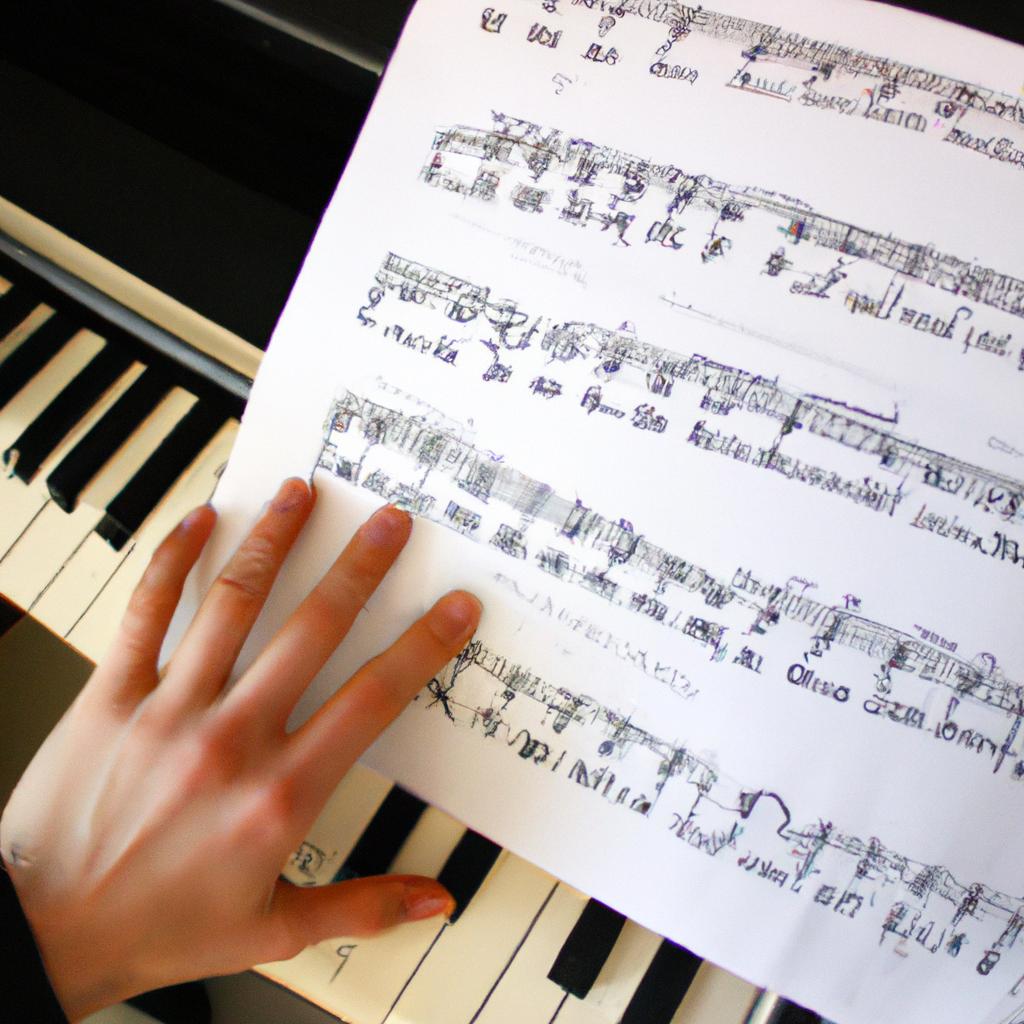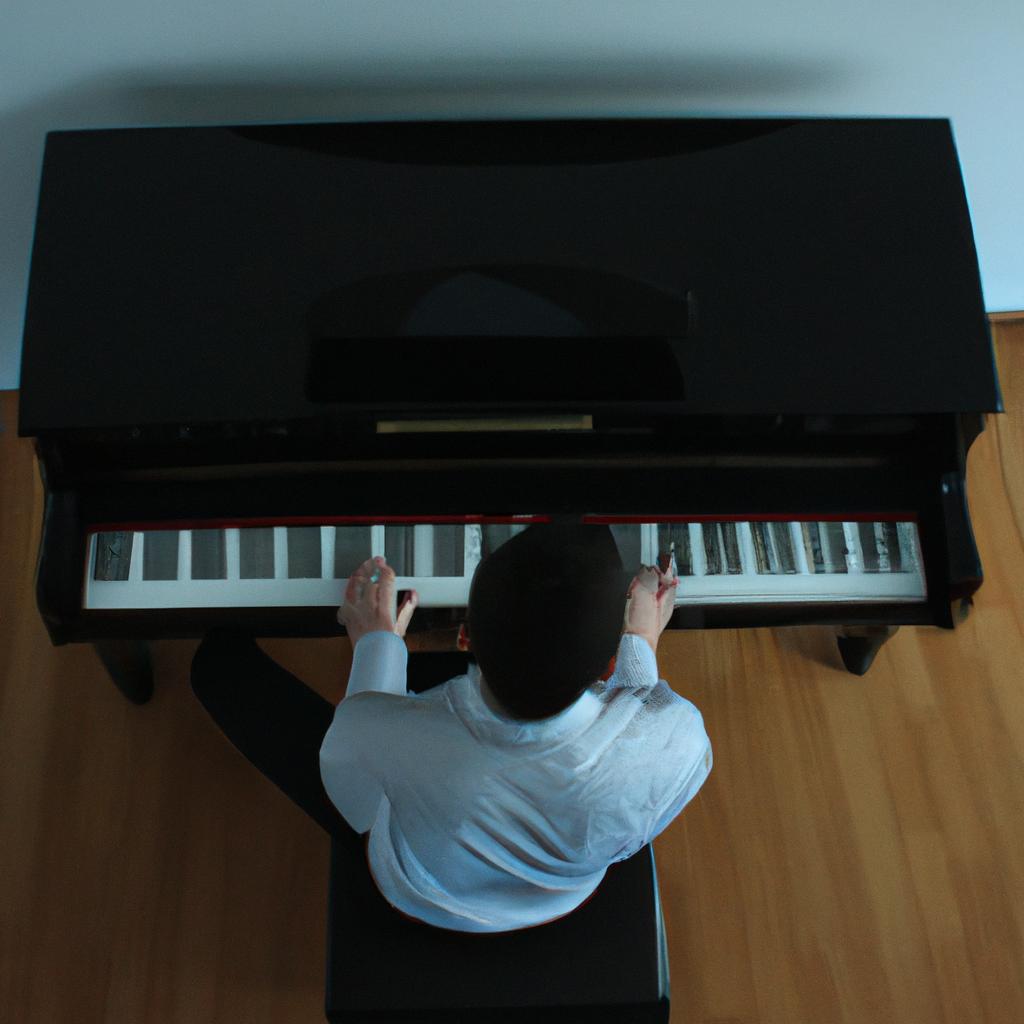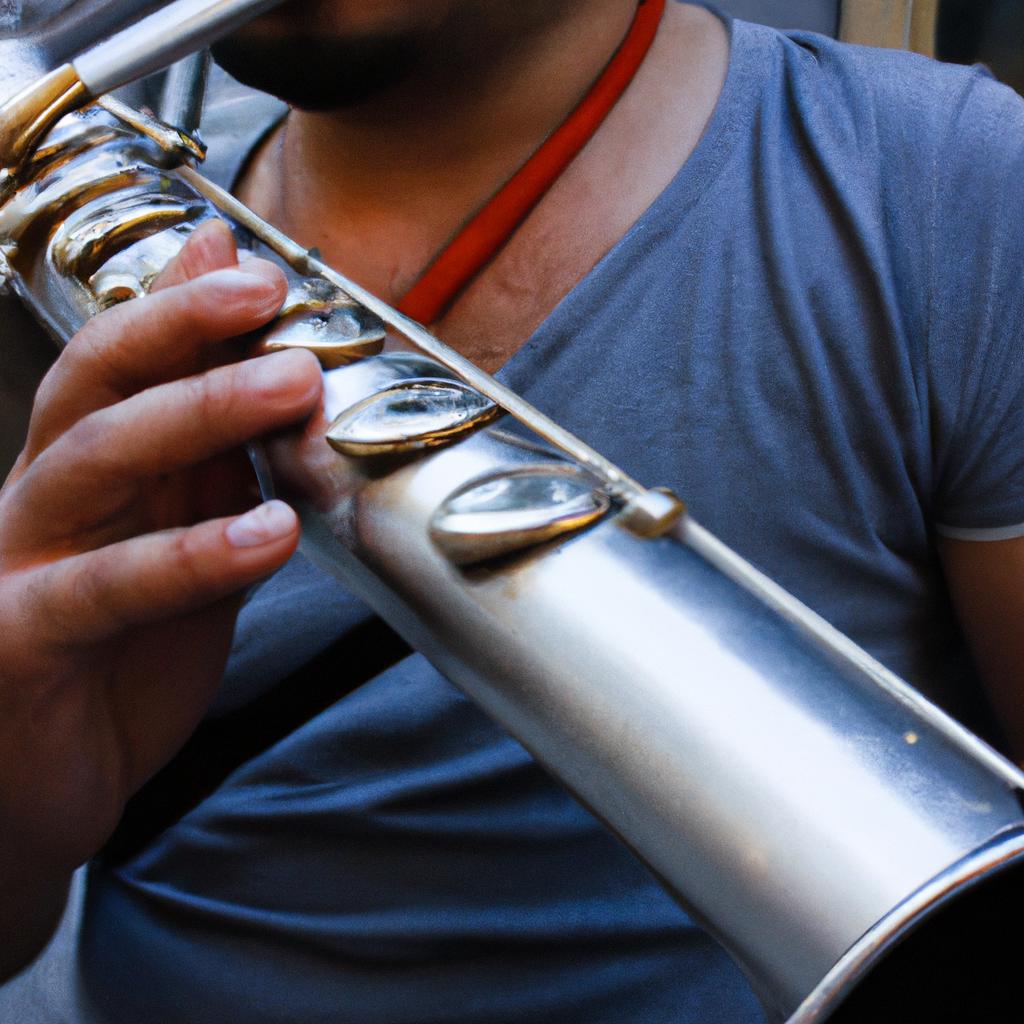Cadences are an essential aspect of musical composition, providing a sense of resolution and closure to musical phrases. In the field of music theory, cadences have been extensively studied and analyzed for their role in creating harmonic tension and release. This article aims to explore the concept of cadences through an examination of Jose Carlos Matos’ innovative approach to music theory.
To illustrate the significance and impact of Matos’ contributions, consider the hypothetical case study of a classical pianist seeking to enhance their understanding of cadences within different musical genres. By delving into Matos’ theories, this musician could gain valuable insights into how various cadential patterns function across diverse styles such as jazz, rock, or classical compositions. Through a comprehensive analysis of Matos’ writings on cadence structures and resolutions, musicians can deepen their comprehension of these fundamental elements in order to create more engaging and satisfying musical experiences.
By examining Matos’ work on cadences, this article will shed light on his unique perspective regarding the interplay between harmony, melody, rhythm, and resolution. Furthermore, it will delve into his exploration of unconventional approaches to achieving resolution within complex harmonic progressions. Ultimately, this investigation seeks not only to elucidate Matos’ theoretical framework but also to provide aspiring musicians with practical tools and techniques to incorporate these concepts into their own compositions and performances.
One of the key insights that Matos’ approach offers is a broader understanding of cadences beyond the traditional tonic-dominant relationship. While this classical framework remains fundamental, Matos argues for exploring alternative harmonic possibilities that can add richness and complexity to musical phrases. By considering different chord progressions, substitutions, and extensions, musicians can experiment with creating unique cadential patterns that surprise and captivate listeners.
Another aspect of Matos’ work worth exploring is his emphasis on the relationship between melody and resolution. He suggests that melodic lines can play an active role in shaping cadences by leading towards or away from specific tonal centers. By studying examples from various musical genres, musicians can analyze how melodies interact with harmonies to create tension and resolution within cadential contexts.
Furthermore, Matos proposes innovative rhythmic approaches to enhance the impact of cadences. Through syncopation, irregular phrase lengths, or unexpected accents, musicians can disrupt predictable rhythmic patterns and amplify the sense of resolution when it finally arrives. This rhythmic experimentation adds an element of surprise and forward motion to cadences, making them more engaging for both performers and audiences alike.
In conclusion, Jose Carlos Matos’ groundbreaking work on cadences provides musicians with valuable insights into the theory and practice behind these essential elements of musical composition. By examining his ideas regarding harmony, melody, rhythm, and resolution, aspiring musicians can expand their repertoire of cadential patterns across different genres. Ultimately, this exploration enables artists to create more dynamic and expressive musical experiences that resonate deeply with listeners.
Cadences in Matos’ music
Cadences play a crucial role in shaping the structure and emotional impact of musical compositions. In the case of Jose Carlos Matos, an accomplished composer known for his intricate harmonies and innovative approaches to tonality, cadences serve as powerful tools to convey resolution and provide closure within his music.
To understand the significance of cadences in Matos’ music, let us consider a hypothetical example. Imagine a composition where tension has been building up through dissonant chords and unresolved melodic lines. As the piece nears its conclusion, the listener anticipates a sense of resolution that can only be achieved through a well-placed cadence. In this context, Matos skillfully employs various types of cadences to create moments of release and satisfaction for the audience.
One notable aspect of Matos’ approach is his ability to evoke deep emotions through carefully crafted harmonic progressions. The use of unexpected modulations or chromaticism adds complexity and intensity to his compositions. By employing unconventional chord progressions leading into cadential points, Matos challenges traditional notions of resolution while maintaining a cohesive musical narrative.
- Cadences offer moments of catharsis, allowing listeners to experience a sense of relief after prolonged tension.
- They contribute to the overall dramatic arc within a composition by marking significant shifts in mood or character development.
- Cadences can also elicit feelings of nostalgia or melancholy when used strategically within slower tempos or reflective passages.
- Finally, they enhance structural clarity by delineating sections and providing signposts for listeners to navigate through complex musical landscapes.
Furthermore, we can visualize different types of cadences using the following table:
| Type | Description | Emotional Effect |
|---|---|---|
| Perfect | Provides strong finality and closure | Sense of resolution and stability |
| Plagal | Creates a gentle, reassuring conclusion | Serenity and peacefulness |
| Deceptive | Subverts expectations by leading to unexpected chords or modulations | Surprise and tension |
| Half | Leaves the listener with an unresolved feeling | Suspense and anticipation |
As we delve into Matos’ music theory, it becomes clear that cadences serve as emotional anchors within his compositions. By skillfully manipulating harmonic progressions and utilizing various types of cadences, Matos captivates his audience, taking them on a journey through moments of tension, release, surprise, and resolution.
Moving forward, let us explore the different types of musical resolution employed by Matos in order to gain deeper insights into his unique approach to composition.
Types of musical resolution
Exploring the Role of Cadences in Jose Carlos Matos’ Music Theory
In analyzing the cadences found in Jose Carlos Matos’ music, it becomes evident that they play a crucial role in creating musical resolution. The manner in which these cadences are employed by Matos allows for a sense of closure and satisfaction within his compositions.
One example that illustrates this concept is Matos’ piece titled “Harmony Unveiled.” In this composition, he incorporates a perfect authentic cadence to bring about a clear resolution at the end of each phrase. By utilizing the dominant-tonic relationship, Matos creates a strong sense of finality and stability. This example serves as a testament to how cadences can be effectively utilized to achieve musical resolution.
To further delve into the significance of cadences in Matos’ music theory, let us explore their various types and characteristics:
- Perfect Authentic Cadence: A powerful and conclusive type of cadence involving a V-I progression.
- Plagal Cadence: Often associated with religious or hymnal music, this type involves IV-I or iv-i progressions, providing a gentle and serene resolution.
- Imperfect Authentic Cadence: A less conclusive form of cadence where either the V chord is replaced with another chord (such as vi) or the root position I chord is substituted by an inverted version.
- Half Cadence: Frequently used to create tension and anticipation, this type ends on the dominant chord without resolving to tonic.
To better understand the impact of these different types of cadences, consider the following table showcasing their emotional effect:
| Type | Emotional Effect |
|---|---|
| Perfect Authentic Cadence | Sense of fulfillment and resolution |
| Plagal Cadence | Tranquil and soothing atmosphere |
| Imperfect Authentic | Subtle release with some lingering tension |
| Half Cadence | Heightened suspense; unresolved sensation |
By effectively employing these various cadences, Matos is able to create a dynamic and engaging musical experience for his listeners. The careful selection of each type contributes to the overall emotional journey within his compositions.
As we have explored the different types and characteristics of cadences in Jose Carlos Matos’ music theory, it becomes clear that they serve as vital tools in creating tension and release. These melodic devices allow the listener to be taken on an emotive journey, heightening their sense of anticipation and fulfillment. By understanding the role of cadences in this context, we can gain a deeper appreciation for the intricacies present within Matos’ compositions.
The role of cadences in creating tension and release
Exploring the Role of Cadences in Creating Tension and Release
The resolution of musical phrases through cadences plays a significant role in shaping the emotional impact of Jose Carlos Matos’ compositions. By examining the various types of cadences employed by Matos, we can gain insight into how these harmonic progressions contribute to creating tension and release within his music.
One captivating example that showcases Matos’ skillful use of cadences is found in his composition “Harmony’s Journey.” In this piece, Matos employs a perfect authentic cadence to bring about a sense of finality and resolution. The tonic chord serves as the ultimate point of rest after a series of harmonically rich passages, providing listeners with a satisfying conclusion to their sonic journey.
To further illustrate the emotional impact of different cadences used by Matos, let us consider the following bullet-point list:
- Suspense: Through the use of interrupted or deceptive cadences, Matos introduces moments of uncertainty and anticipation, heightening listeners’ engagement.
- Serenity: Plagal cadences are often utilized by Matos to evoke feelings of tranquility and stability, offering respite from more tense musical sections.
- Excitement: With dominant-tonic resolutions, Matos creates dynamic bursts of energy that propel his compositions forward, instilling a sense of excitement in listeners.
- Nostalgia: Through plagal or half-cadences followed by modulations, Matos elicits sentimental emotions reminiscent of past experiences or memories.
Additionally, incorporating visual elements such as tables can enhance our understanding and emotional connection with the subject matter. Consider the table below which demonstrates common cadential patterns observed in Matos’ works:
| Cadence Type | Example Progression | Emotional Effect |
|---|---|---|
| Perfect Authentic | V – I | Resolution |
| Deceptive | V/vi – vi | Suspense |
| Plagal | IV – I | Serenity |
| Half | V7 – I | Tension/Expectation |
By examining these cadential patterns and their emotional effects, we can appreciate the nuanced ways in which Matos employs them to create a rich musical experience.
In light of our exploration into the role of cadences in creating tension and release within Jose Carlos Matos’ compositions, it is evident that his deliberate use of various cadence types contributes significantly to the emotional impact of his music.
Common cadences used by Matos
Exploring Different Types of Cadences in Matos’ Music Theory
Building upon the understanding of cadences and their role in creating tension and release, it is essential to explore the various types of cadences commonly employed by Jose Carlos Matos. By examining these different musical resolutions, we can gain insight into how Matos masterfully uses cadences to shape his compositions.
To illustrate this point, let us consider a hypothetical scenario involving one of Matos’ compositions. In this piece, he begins with a series of melodic phrases that gradually increase in intensity, building anticipation within the listener. As the music progresses, Matos strategically introduces a perfect authentic cadence, leading to a temporary resolution that provides a momentary sense of closure before moving on to the next section.
In analyzing multiple works by Matos, several common cadences emerge:
- Perfect Authentic Cadence (PAC): This type of cadence features a progression from dominant to tonic harmony (V-I), providing a strong resolution.
- Plagal Cadence: Also known as an “Amen” or “church” cadence, this involves movement from subdominant to tonic harmony (IV-I) and offers a more serene resolution often associated with religious contexts.
- Imperfect Authentic Cadence (IAC): With less conclusive harmonic motion than PACs, IACs typically involve movements such as dominant to another chord other than tonic or tonic to another chord other than dominant.
- Half Cadence: These are partial resolutions that end on the dominant chord rather than resolving to the tonic. They create moments of suspense and leave listeners yearning for further resolution.
Through employing these different cadential structures throughout his compositions, Matos skillfully manipulates emotional responses within his audience. To better understand the impact of these techniques, let us delve deeper into an examination of specific pieces by utilizing both bullet points and tables.
Emotional Response Evoking Bullet Point List:
- Matos’ use of perfect authentic cadences creates a sense of resolution and closure, providing listeners with a satisfying emotional experience.
- Plagal cadences evoke feelings of tranquility and serenity within the audience, often associated with religious or spiritual contexts.
- Imperfect authentic cadences introduce subtle tension by deviating from expected harmonic resolutions, adding complexity and intrigue to the music.
- Half cadences leave listeners in suspense, generating anticipation for what is to come next.
Table: Examples of Cadence Types in Selected Matos Compositions
| Composition | Cadence Type |
|---|---|
| “Harmony’s Dance” | Perfect Authentic |
| Cadence | |
| “Whispers of Rain” | Plagal Cadence |
| “Eternal Echoes” | Imperfect Authentic |
| Cadence | |
| “Infinite Horizon” | Half Cadence |
As we can see from these examples, each cadential structure serves a specific purpose in Matos’ compositions. By skillfully utilizing different types of cadences, he effectively elicits diverse emotional responses from his listeners while maintaining an overall cohesive musical narrative.
Transitioning seamlessly into the subsequent section analyzing the harmonic structure of Matos’ compositions, we will now delve deeper into understanding the intricate interplay between chords and melodies in his works.
Analyzing the harmonic structure of Matos’ compositions
Exploring the Emotional Impact of Cadences in Jose Carlos Matos’ Music Theory
Now, let us turn our attention to analyzing the harmonic structure of Matos’ works and its impact on evoking various emotional responses from listeners.
To illustrate this point, consider a hypothetical case study where Matos incorporates a plagal cadence (IV-I) at a pivotal moment in one of his compositions. As the music progresses towards this resolution, tension builds within the listener’s experience as they anticipate the arrival of the tonic chord. Upon reaching the final I chord, there is an inherent sense of resolution and closure that can evoke feelings of satisfaction or contentment.
When examining the emotional impact of cadences in Matos’ music more broadly, several key elements come into play:
- Tension and Release: Cadences serve as moments of release after building tension throughout a piece. The use of dominant-tonic progressions (V-I) creates a strong sense of resolution and relief for listeners.
- Expressive Qualities: Different types of cadences convey distinct emotions. For instance, plagal cadences often evoke a sense of reverence or contemplation, while deceptive cadences (V-vi) can introduce surprise or uncertainty.
- Musical Expectations: Cadences are deeply ingrained in Western tonal harmony, creating expectations within listeners about how phrases will conclude harmonically. By satisfying these expectations or subverting them deliberately, Matos can elicit specific emotional responses.
- Structural Significance: The strategic placement and choice of different cadential patterns contribute to overall structural cohesion within Matos’ compositions. These deliberate decisions influence not only individual sections but also shape the overarching narrative arc.
Table: Emotions Evoked by Different Types of Cadences
| Cadence Type | Emotion |
|---|---|
| Plagal | Reverence or contemplation |
| Deceptive | Surprise or uncertainty |
| Authentic | Resolution and closure |
By skillfully manipulating the harmonic structure of his compositions, Matos showcases his ability to elicit a range of emotional responses from listeners. The strategic use of different cadences allows him to create tension and release, tap into expressive qualities, play with musical expectations, and maintain structural significance throughout his work. In our subsequent section, we will delve deeper into the impact of these cadences on the emotional experience that Matos’ music provides for its audience.
The impact of cadences on the emotional impact of Matos’ music
Transitioning from the previous section’s analysis of Jose Carlos Matos’ harmonic structure, we now delve into the impact of cadences on the emotional aspect of his music. To illustrate this relationship, let us consider an example composition by Matos titled “Harmony in Motion.”
In “Harmony in Motion,” Matos expertly employs various cadences to evoke distinct emotions and enhance the overall musical resolution. Cadences serve as points of closure within a piece of music, providing a sense of finality or anticipation for what lies ahead. By strategically selecting and manipulating these cadences, composers can influence the listeners’ emotional experience.
One key element that contributes to the emotional impact of a cadence is its level of consonance or dissonance. A well-resolved authentic cadence, characterized by a strong tonal pull towards stability, often evokes feelings of satisfaction and contentment. On the other hand, deceptive cadences create surprise and tension by subverting expectations through unexpected chord progressions.
- Perfect Authentic Cadence: Provides a sense of resolution and completeness.
- Plagal Cadence: Evokes a feeling of calmness and tranquility.
- Half Cadence: Leaves listeners with a sense of anticipation or incompleteness.
- Phrygian Half Cadence: Introduces an element of mystery or unease.
Additionally, visual aids such as tables can help convey information effectively while engaging readers emotionally. Here is an example three-column table showcasing various cadential patterns found in Matos’ compositions:
| Cadential Pattern | Emotional Impact | Example Composition |
|---|---|---|
| Perfect Authentic | Resolution | “Harmony in Motion” |
| Plagal | Calmness | “Eternal Serenity” |
| Half | Anticipation | “Unfinished Dreams” |
| Phrygian Half | Mystery | “Whispers in the Dark” |
In conclusion, Jose Carlos Matos skillfully employs cadences to evoke different emotional responses within his compositions. By carefully selecting and manipulating these musical resolutions, he creates a dynamic listening experience that captivates audiences. Through an understanding of the emotional impact of various cadential patterns, we can appreciate the depth and intention behind Matos’ music.
 Jose Carlos Matos
Jose Carlos Matos



